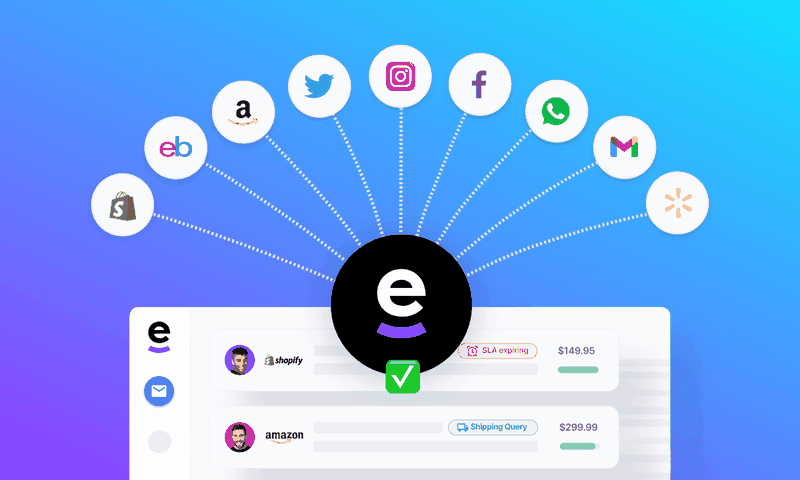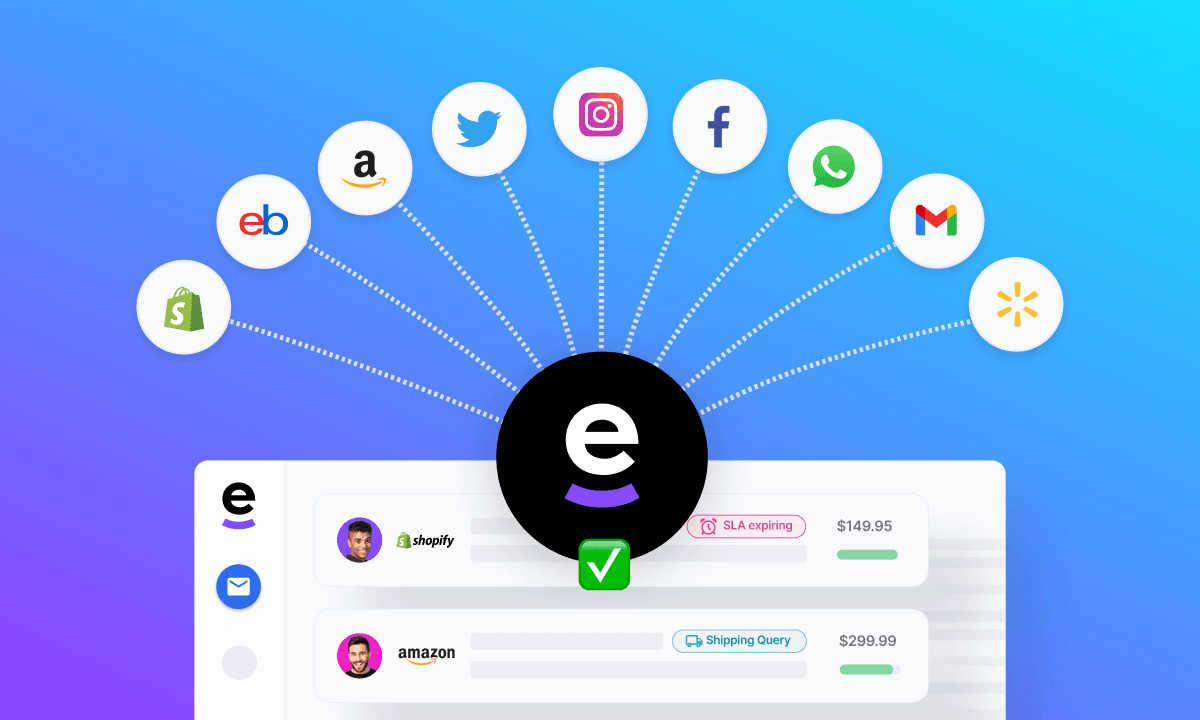¿Expandir tu negocio de comercio electrónico para vender en múltiples canales te parece una tarea desalentadora? Con las estrategias de crecimiento multicanal adecuadas, puede ser una forma estupenda de lograr un crecimiento rápido.
Aquí tienes tres consejos que te ayudarán a empezar.
● Adopta un enfoque estratégico: Antes de expandirte a nuevos mercados, dedica tiempo a desarrollar una estrategia bien pensada. Así te asegurarás de que tus esfuerzos están bien enfocados y de que tienes un plan para superar los retos que puedan surgir.
● Investiga: Asegúrate de que conoces bien cada mercado antes de lanzarte a él. ¿Cuáles son los puntos de venta únicos (USP) de ese mercado? ¿Cómo es la competencia? ¿Cómo se comportan los compradores en ese mercado?
● Prepárate para los contratiempos: Por desgracia, ninguna estrategia es perfecta, y es probable que haya algunos baches en el camino. Ten preparados imprevistos para poder abordar rápidamente cualquier problema que surja.
Siguiendo estos consejos, puedes preparar tu negocio de comercio electrónico para el éxito cuando te expandas a nuevos mercados.
Si necesitas ayuda para empezar, eDesk está aquí para ayudarte. Somos el proveedor líder de software de atención al cliente de comercio electrónico, y nuestra plataforma está diseñada para ayudar a las empresas a tener éxito en múltiples mercados.

Formas de ampliar tu negocio de comercio electrónico
Hay muchas formas de aumentar el crecimiento del comercio electrónico, como el marketing en redes sociales, el marketing por correo electrónico, las pruebas A/B y el retargeting. Por supuesto, cada método tiene sus propias ventajas e inconvenientes, por lo que es importante elegir los que mejor funcionen para tu negocio.
A pesar de tus opciones, hay una clara ganadora: adoptar un enfoque multicanal. Crear un perfil y publicar tus productos en mercadillos como Amazon, eBay y Etsy puede ayudarte a llegar a un público más amplio y a aumentar las ventas.
Esto también tiene sus inconvenientes, como los problemas en la cadena de suministro, la confusión de marca y el aumento de las demandas de atención al cliente. Sin embargo, pueden resolverse con las numerosas herramientas de atención al cliente de eDesk.
En este artículo, hablaremos de las estrategias de crecimiento multicanal y de los problemas habituales con los que te puedes encontrar, así como, por supuesto, de las soluciones a estos problemas.
10 enfoques comunes para el crecimiento del comercio electrónico
1. Amplía tu oferta de productos
El primer enfoque a considerar es ampliar tu oferta de productos. Esto puede hacerse de varias maneras, como añadiendo nuevos productos o categorías, dirigiéndote a nuevos mercados o expandiéndote a nuevos canales.
Ampliar tu oferta de productos tiene muchas ventajas. Por un lado, puede ayudarte a mantenerte competitivo y al día de las últimas tendencias. Además, puede ayudarte a atraer nuevos clientes y aumentar las ventas. Y, por último, puede ayudarte a diversificar tu negocio y reducir tu dependencia de un solo canal o mercado.
También existen algunos riesgos asociados a la expansión de los productos. Por un lado, puede ser difícil gestionar eficazmente varias líneas de productos. Además, tienes que asegurarte de que tus productos encajan bien en los nuevos mercados a los que te diriges. Si no lo son, podrías acabar vendiendo productos que nadie quiere comprar.
2. Entrar en nuevos mercados
A la hora de expandirse a nuevos mercados, hay que tener en cuenta varias cosas. Por un lado, entrar en nuevos mercados puede ser una forma estupenda de hacer crecer tu negocio. Al acceder a nuevas zonas geográficas o demográficas, puedes exponer tu marca a nuevos clientes y aumentar las ventas.
Por otra parte, tienes que asegurarte de que conoces bien los mercados a los que te diriges y de que tus productos encajan bien. Si no investigas, podrías acabar cometiendo errores costosos.
3. Aumentar la visibilidad online
Otro enfoque para hacer crecer tu negocio de comercio electrónico es aumentar tu visibilidad online. Esto puede hacerse a través de distintos canales, como la optimización para motores de búsqueda (SEO), el marketing en redes sociales y el marketing por correo electrónico.
Aumentar tu visibilidad en Internet tiene muchas ventajas. Una visibilidad adicional puede ayudarte a llegar a nuevos clientes que buscan tus productos en Internet. Además, puede ayudarte a establecer relaciones con clientes potenciales y crear conciencia de marca. Por último, puede ayudarte a atraer tráfico a tu sitio web y aumentar las ventas.
También existen algunos riesgos asociados al aumento de tu visibilidad en Internet. Puede llevar mucho tiempo y ser caro. Además, si no lo haces correctamente, podrías acabar dañando la reputación de tu marca.
4. Optimiza tu sitio web para las conversiones
Otro enfoque para hacer crecer tu negocio de comercio electrónico es optimizar tu sitio web para las conversiones. Esto significa asegurarte de que tu sitio web está diseñado de forma que anime a los visitantes a realizar la acción deseada, ya sea comprar, suscribirse a un boletín o descargar un producto.
Optimizar tu sitio web para la conversión tiene muchas ventajas. Por un lado, puede ayudarte a aumentar las ventas y hacer crecer tu negocio. Además, puede ayudarte a mejorar el ROI de tus campañas de marketing. Por último, puede ayudarte a crear una mejor experiencia de usuario para tus visitantes.
También existen algunos riesgos asociados a la optimización de tu sitio web para la conversión. Puede ser costoso y llevar mucho tiempo, lo que significa que estás quitando recursos que podrían utilizarse mejor en otras partes de tu negocio. Además, si no lo haces correctamente, podrías acabar ahuyentando a clientes potenciales.
5. Centrarse en el móvil
El estadounidense medio pasa más de cinco horas al día en sus dispositivos móviles, y esa cifra no hace más que aumentar. Como resultado, no es de extrañar que el comercio móvil (mCommerce) esté creciendo a un ritmo rápido. Las ventas minoristas de comercio móvil alcanzarán los 359.320 millones de dólares en 2021, un aumento del 15,2% respecto a 2020. En 2025, las ventas minoristas de mCommerce deberían más que duplicarse para alcanzar los 728.280 millones de dólares y representar el 44,2% de las ventas minoristas de ecommerce en EE.UU.
Si no te centras en los móviles, estás perdiendo una gran oportunidad. Asegúrate de que tu sitio web es responsivo y está optimizado para dispositivos móviles. Además, considera la posibilidad de crear una aplicación móvil para ofrecer una experiencia aún mejor al cliente.
Al centrarte en el móvil, podrás llegar a más clientes y aumentar tus ventas, pero hay que tener en cuenta algunos inconvenientes.
En primer lugar, desarrollar una tienda web y una aplicación móvil puede ser caro. No sólo tienes que contratar a un desarrollador, sino también presupuestar las pruebas y el marketing.
En segundo lugar, no todos los clientes prefieren comprar en dispositivos móviles. Algunas personas siguen prefiriendo comprar en ordenadores de sobremesa o portátiles.
6. Mejorar el servicio al cliente

Un mejor servicio al cliente puede significar clientes más satisfechos, que probablemente serán más fieles y volverán para futuras compras.
Además, es más probable que los clientes satisfechos recomienden tu empresa a otras personas. Esto puede conducir a un aumento del marketing boca a boca y a más negocios.
Alcanzar este objetivo puede requerir que contrates más personal, pero a menudo esto puede evitarse invirtiendo en tecnología de atención al cliente de comercio electrónico y programas de formación adecuados. Además, puede que tengas que cambiar tus procesos empresariales y tu estructura organizativa para apoyar un mejor servicio al cliente.
7. Invierte en marketing en redes sociales
El marketing en redes sociales es una de las estrategias de marketing digital más eficaces que existen. No sólo te permite conectar con tu público objetivo, sino que también te da la oportunidad de mostrar la personalidad de tu marca.
Invertir en marketing en redes sociales te ayudará a llegar a un público más amplio y a establecer relaciones con clientes potenciales y existentes. Además, es una forma estupenda de estar siempre presente y mantener la relevancia de tu marca.
Las desventajas del marketing en redes sociales son que puede llevar mucho tiempo y puede ser difícil medir los resultados. Tienes que estar preparado para invertir tiempo y esfuerzo en los medios sociales si quieres ver buenos resultados. E, incluso entonces, puede ser difícil determinar si tus esfuerzos están dando sus frutos.
8. Utiliza el marketing por correo electrónico para impulsar las ventas
El marketing por correo electrónico es otra estrategia eficaz de marketing digital que puede ayudarte a llegar a tu público objetivo e impulsar las ventas.
Si creas una lista de suscriptores y les envías correos electrónicos dirigidos, podrás mantenerte en primera línea, establecer relaciones e impulsar las ventas. Sólo asegúrate de no pasarte con los correos electrónicos o corres el riesgo de acabar en la carpeta de spam.
El inconveniente del marketing por correo electrónico es que puede llevar mucho tiempo crear y enviar correos electrónicos. Además, si no tienes una gran lista de suscriptores, puede que no veas muchos resultados de tus esfuerzos.
9. Realiza pruebas A/B para mejorar las tasas de conversión
Las pruebas A/B, también conocidas como pruebas divididas, son un método de comparar dos versiones de una página web para ver cuál funciona mejor.
Puedes probar cualquier elemento de tu página web, desde el titular hasta el botón de llamada a la acción. Probando distintos elementos, puedes averiguar qué funciona mejor para tu público y tu negocio.
El inconveniente de las pruebas A/B es que pueden llevar mucho tiempo y ser caras. Tienes que crear dos versiones de tu página web y luego hacer un seguimiento de los resultados para ver cuál funciona mejor.
Además, las pruebas A/B requieren mucho tráfico en tu sitio web para obtener resultados precisos. Si no tienes mucho tráfico, el esfuerzo puede ser mayor que el beneficio.
10. Utiliza el retargeting para llegar a clientes potenciales
El retargeting es una forma de publicidad online que te permite mostrar anuncios a personas que ya han visitado tu sitio web.
Es una forma estupenda de mantenerte en primera línea y aumentar las posibilidades de que esos visitantes vuelvan y realicen una compra.
El inconveniente del retargeting es que puede ser caro. Necesitas un presupuesto lo suficientemente grande para llegar a un número significativo de personas. Además, el retargeting puede ser intrusivo y molestar a algunos usuarios.
El mejor enfoque: utilizar estrategias de crecimiento multicanal
El enfoque de marketing multicanal ofrece una forma estupenda de hacer crecer tu negocio de comercio electrónico. Estas estrategias te permiten llegar a una gran audiencia de clientes potenciales, y facilitan que los compradores encuentren y adquieran tus productos.
Además, los mercadillos multicanal ofrecen un montón de valiosas características de marketing y venta que pueden ayudarte a vender más productos y a hacer crecer tu negocio. Son una forma estupenda de diversificar tus canales de venta y aumentar tu presencia en Internet.
Sin embargo, no todo es sol y arco iris. Vender en múltiples canales y mercados puede plantear dificultades. He aquí algunos ejemplos de empresas que han abordado estos problemas.
1. Gestión de las cadenas de suministro

Uno de los mayores problemas a los que te enfrentarás al vender en mercados multicanal es la gestión de tu cadena de suministro y la gestión del inventario en varias plataformas diferentes. Esto puede ser difícil y llevar mucho tiempo, y puede provocar roturas de stock y retrasos en el cumplimiento de los pedidos.
La solución
Para superar este problema, necesitas desarrollar un sólido sistema de gestión de inventarios. Este sistema debe realizar un seguimiento de los niveles de inventario en todos tus canales de venta, y también debe automatizar la realización y el envío de los pedidos. Automatizando estos procesos, puedes minimizar el riesgo de falta de existencias y los retrasos en el cumplimiento de los pedidos.
2. Confusión de marca
Cuando vendes en varios mercadillos, es importante asegurarte de que tu marca está bien representada en todos ellos. Sin embargo, existe el riesgo de que los compradores se confundan sobre qué plataforma es la fuente oficial de tus productos. Esto puede provocar la pérdida de ventas y la disminución de la lealtad a la marca.
La solución
Para evitar este problema, debes crear una sólida estrategia de marca para tu presencia en el mercato. Tu marca debe ser coherente en todos tus canales, y debe comunicar claramente qué plataforma es la fuente oficial de tus productos. También puedes plantearte desarrollar campañas de marketing únicas, específicas para cada canal.
3. Aumento de los costes de comercialización
Otro problema al que te enfrentarás al vender en múltiples canales y mercados es el aumento de los costes de marketing. Cuando vendas en varias plataformas, tendrás que invertir en campañas de marketing para cada una de ellas. Esto puede ser costoso, y puede no ser factible para las pequeñas empresas.
La solución
Para superar este problema, tienes que reconsiderar tu estrategia de marketing. Asegúrate de que te diriges al público adecuado, y utiliza los datos de tus campañas de marketing para optimizar tus gastos. Además, considera la posibilidad de utilizar herramientas de automatización del marketing para ayudarte a gestionar tus campañas y reducir tus costes.
4. Las barreras lingüísticas pueden ser un gran problema
Al vender en múltiples geografías, tendrás que enfrentarte al hecho de que algunos compradores pueden no hablar tu idioma. Esto puede ser un gran problema si intentas vender internacionalmente.
La solución
Superar este reto podría implicar contratar a representantes de atención al cliente locales o que dominen las lenguas de tus mercados objetivo, pero esto puede ser costoso y difícil de gestionar. Como alternativa, las soluciones multilingües de atención al cliente pueden ahorrarte tiempo y dinero. Además, asegúrate de que tus listados están configurados para mostrar los precios en la moneda local.
5. Exigencias del servicio al cliente

Otro problema al que te enfrentarás cuando utilices múltiples canales de venta y mercadillos es el aumento de la demanda de tu equipo de atención al cliente. Cuando vendas en múltiples plataformas, tendrás que ocuparte de los problemas de atención al cliente en todas ellas. Esto puede llevar mucho tiempo y resultar caro, y puede exigirte contratar personal adicional.
La solución
Invierte en buenas herramientas y sistemas de atención al cliente que te ayuden a automatizar los procesos rutinarios de atención al cliente y te permitan gestionar las consultas de los clientes desde múltiples canales en un solo lugar.
6. Gestionar las comunicaciones multicanal con los clientes
Cuando vendas en varios mercadillos, tendrás que ocuparte de las comunicaciones con los clientes en todos ellos. Esto puede ser un reto, ya que tendrás que hacer un seguimiento de las conversaciones en múltiples plataformas. Además, los compradores pueden sentirse frustrados si tienen que ponerse en contacto contigo en distintos canales por cuestiones diferentes.
La solución
Para superar este problema, invierte en buenas herramientas de gestión de la comunicación con el cliente, que te faciliten la comunicación en tiempo real, prioricen los tickets de soporte urgentes, automaticen las respuestas cuando proceda y conviertan las buenas experiencias de los clientes en buenas críticas.
Reflexiones finales
Vender en múltiples canales y mercadillos es la forma más fácil de aumentar la exposición de tu empresa a un público más amplio. Nuestras soluciones de atención al cliente pueden ayudarte a gestionar todas las comunicaciones con tus clientes en una ubicación central, reducir tus costes y mejorar tu reputación.
Ponte en contacto con nosotros hoy mismo para saber más sobre cómo podemos ayudarte a hacer crecer tu negocio online con un extraordinario servicio de atención al cliente.




